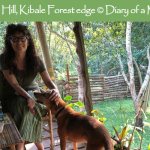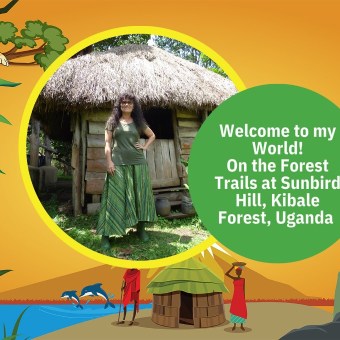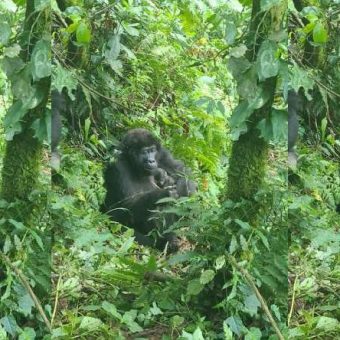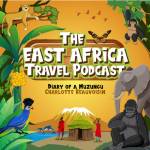
The muzungu’s experience tracking chimpanzees in Uganda’s Kibale Forest and some tips for would-be trackers!
Chimps are the drama queens par excellence.
Most of my chimp encounters have been here at Sunbird Hill on the edge of Kibale Forest, where we frequently hear their pant hoots and the deep sound of buttress drumming that echoes through the forest. Chimps use this noise to communicate when they find food; it may also indicate the group is about to move. It doesn’t matter how often we hear the chimpanzees, it’s always exciting. We look at each other and ask “what are the chimps up to now?!”
I’ve been wanting to track the chimps for years. My primatologist friend Julia Lloyd led the team that habituated chimpanzees that tourists visit in Kibale Forest. How could I track without her?
However, after a year living tantalisingly close to the forest action, I couldn’t wait any longer: one birthday Cath, a one-time VSO volunteer like me, booked to see the chimps.
I’ve heard stories of multiple groups of tourists converging on the same group of chimpanzees. That’s not what I wanted. I wondered what my experience would be like?
NOTE: I went chimp tracking in Kibale Forest before the pandemic. Scroll down to the comments to read the Standard Operating Procedures that you will be expected to follow if you track chimpanzees or gorillas from now on.
Pant hoots and knuckle spins
“Welcome to Kibale National Park, a tropical rainforest, known as the primate capital of the world because of its high number of chimpanzees. Our afternoon of chimp tracking may take one or three hours.”
Before we embark on our forest adventure, our ranger guide Benson explains how we will be tracking the Kanyantale chimpanzee community who move through the forest in groups. “They are communities rather than tight-knit families like gorillas.” Ntale is the local Rutoro word for lion (not on Kibale’s species list, you may be relieved to hear!)
I’m super excited when I realise that there will be only two of us (plus Benson) for our afternoon tracking. We’ve lucked out!
As we enter Kibale Forest, we see evidence of elephants: broken trees lie across our path. Benson points to muddy streaks on tree trunks, where elephants have been rubbing their hulks to clean themselves – and marking their territory at the same time.
It’s a warm humid day. Our noses detect a fruity smell and Benson points out a chimp’s (night) nest above us. At our feet are half-eaten figs. Among the decaying leaves, roots and tree trunks lie cross farum, big fruits beloved by chimps (and inedible to us).
It’s thrilling to be in the middle of the forest (rather than at its edge). I feel my lungs expand to take in every atom of forest air. It smells so good.
We walk uphill and down. Are the chimps watching us, high in the trees?
Fifteen minutes pass.
Benson tries to contact another ranger but his radio is off. We continue wandering through the forest, but there is no sign of the chimpanzees. They seem to have disappeared.
Are we going to see the chimpanzees? Perhaps today is not our day. I let the disappointment wash over me. I know I’ll have other chances and being in the forest is a delight all of its own, but what of Cath? For her sake, I hope today is our day.
We can’t see the chimps, nor can we hear them. Can Benson?
“Hello. Hello Musa? Hello?” Benson is on the phone. He sounds worried.
“I don’t know where he left the chimpanzees. I am tracking and I have failed.”
I stifle a giggle.
“They are almost at the boundary with Julia’s,” he tells us. “They are moving toward the community” (outside the National Park).
We walk off track, pushing through low-hanging branches and creepers. Our destination is a towering fig tree on the park boundary.
“They are starting to move seriously” and so are we! We are almost running now.
“Look at the knuckle print; it’s fresh!” And there in the soft mud is the perfect outline of a primate’s knuckle. This is what I have come to see.
“Do you hear them?” Benson quizzes us. “Let’s move now, quickly!”
“We are really tracking!” I say out loud.
We hear a noise and pause, assuming it will be chimpanzees. We listen more carefully and recognise it as the Western Nicator, a bird we know from Sunbird Hill on the other side of the elephant trench.
“It’s a big one. I can see it!”
Benson cranks up the excitement levels. “See – more knuckle prints!” We follow, alert. “We should see the chimpanzees any time.”
The knuckle prints stop.
“Look,” he says as he points to a knuckle spin on the muddy trail. “This is where he has turned around.”
We can clearly see where the animal has spun around. We retrace our steps.
“Chimpanzees don’t like wet ground or water.” (Luckily the muzungu has her gum boots on!)
We hear the screams of chimpanzees in the distance. We leave the track and walk across a small wooden plank into the sunlight.
I stumble. In our rush to see the chimpanzees, I fall down a hole that is hidden by leaves and vegetation.
“They are on the ground ahead!” says our guide.
The deep thud of buttress drumming resonates through the trees.
Ahead of me, Cath turns on her heels, wide-eyed and yells at me “THIS IS AMAZING!”
I’m breathless. I expect trees and I expect distance but somehow I have not factored in hills. We are climbing now. There is no path; in our haste, we trip over tree roots and branches. Benson is slightly anxious. He wants us to push on.
I glimpse black fur and a pink bottom. The chimpanzees are on the ground now, pacing steadily forward. We are moving through their territory now.
Piercing screams fill the air.
“WE ARE GOING TO MISS THEM!” Shouts our guide.
With my heart pounding, I pause to catch my breath. We are racing to cross the track before the chimpanzees disappear. I see one chimp ahead of us. We are very close to the park boundary and Julia’s land now.
To our left there is loud screaming. What a din!
Ahead of us two chimps walk on the ground.
“They are inviting the others for supper,” says our guide, now confident.
He points to the female chimpanzee in oestrus (ready to mate). She has a swollen and painful-looking pink bum.
“She is so attractive to males,” Benson adds. Well, clearly! Nine or ten noisy male chimps compete raucously for the three females who are in oestrus.
We crane our necks and look up through the canopy of the tall Ficus mucuso fig tree. Leaves and figs fall around us. Something lands in my eye. The air buzzes with fruit flies.
“See the baby?” We watch a mother chimp with a baby on her back.
Of the 120 chimpanzees in Kibale’s Kanyantale community, we see around 15 individuals.
[I tell you what, it’s difficult to photograph a moving black shadow when you’re straining to look upwards while kneeling in the undergrowth and being rained on by figs!]
“Look one of the chimpanzees is making a nest,” Benson says and points upwards. “Come quickly – before they climb.” (It’s easier to see and photograph the primates on the ground and lower branches). It’s about four in the afternoon.
I don’t seem to be able to walk fast enough right now! Gumboots are no match for the slippery forest floor.
“Tintina is looking for food, he is shy.”
Tintina is one of Kibale’s oldest chimpanzees. He’s 44 years old and “very musticular.” (This Uglish pronunciation always tickles me). He is calm “not like those other guys.” The forest is quiet now and we pause for a few minutes to absorb the moment.
Mzee Tabu! I congratulate myself on recognising Tabu, a well-known elder of the community.
Seconds later, the silence is broken. Screams come from every direction, above us and around us.
We crunch forest debris underfoot as we pick up the pace and stride onwards.
It’s now 4.30.
“But it’s time to go back now,” Benson tells us. “It’s
going to get dark and this is the time for elephants.” Kibale Forest clearly
still has more mysteries for us.
The muzungu’s chimp tracking tips
Chimpanzee tracking is a popular tourist activity, particularly here in Kibale where it’s the main draw for many visitors to Uganda. There’s no guarantee that you’ll see the chimpanzees yet there’s a 90% likelihood you will.
If you’re chimp tracking in Kibale Forest, you can track first thing in the morning or at 2 o’clock in the afternoon. Morning tracking can be easier because the rangers will know where the chimps have slept. Others recommend tracking in the afternoon as chimps are more likely to be down on the ground (so you are not going to strain your neck for an hour!) We tracked on a Saturday afternoon at the end of September.
What should I wear to track chimps?
- The ideal footwear is ankle-high walking boots. There are plenty of holes, hidden tree trunks and tripping hazards galore. Protect those ankles. Trainers don’t give much grip. Gum boots protect your legs from nettles, thorns and ants (but I always feel dehydrated after wearing them for a few hours). Locals will say they like gum boots as they feel protected from snakes! (You are very unlikely to come across a snake when you are chimp tracking).
- Tuck your socks in. This keeps various creatures out!
- Carry a rain jacket. It can start raining anytime in the Kibale Forest. Clue: tropical rainforest!
- Take – and remember to drink – plenty of water.
What else do we know about the chimpanzees of Kibale National Park?
Kibale is home to 1,450 chimpanzees, according to the last census.
Research and tourism concentrates on 500 chimpanzees living in five communities. Three of them are the research communities of Kanyawara, Ngogo and Sebitoli. Two of the chimpanzee communities are open for tourism. Kanyanchu is the base for tracking the Kanyantale group. Barega is where tourists can participate in chimp habituation.
Chimp tracking rules
- Always pay heed to the Uganda Wildlife Authority rangers’ advice.
- Keep a distance of ten metres at all times “but we have those stubborn ones that may come closer” says the ranger. (NOTE: because of high risks of primates catching COVID-19, the 10-metre rule is standard for both chimp and gorilla tracking now)
- Remember we share virtually the same genes. This makes chimpanzees (and mountain gorillas) highly susceptible to our everyday diseases, including Coronavirus.
- You should not enter any of Uganda’s great ape forests if you’re splattering and coughing. Be responsible and don’t track if you have a cold. (If you are ill, permits can be refunded, at the discretion of the authorities).
- If you want to make use of ‘the bush toilet’, go off trail. The guide will tell you what to do and (take your TP back home with you).
- Be as quiet as possible. Do not mimic the vocalisations of chimpanzees. (You don’t want to be responsible for what might happen next!)
- Don’t use flash photography
- You will have maximum one hour with the chimps. Get out from behind the camera 😊
A few facts about chimpanzees
- Every night chimpanzees make a new nest “to confuse predators such as crowned eagles, leopards and snakes.”
- The average lifespan of a wild chimpanzee is 55 years. They can live up to 65 years in captivity.
- A chimpanzee’s diet is fairly diverse (rather like we humans). 40% of their diet is figs, of which there are 13 different types in the forest. 30% of their diet is fresh meat, 10% is wasps, bees and honey. 10% is dead wood and soil which they consume for the minerals. Dr. Jane Goodall – famous for her ground-breaking study of the chimpanzees of Gombe in Tanzania – was the first person to observe chimps eating other animals. She observed them hunt and eat small mammals such as monkeys and watched them use sticks to extract termites.
- A female chimp will be in oestrus (ready to conceive) for 29 to 32 days every four years.
How much does it cost to track the chimpanzees in Kibale?
The cost to track chimpanzees in Kibale in 2022 is $200 per person. For this, you get to spend maximum one hour with the chimpanzees. You have to be 12 years or older to track chimpanzees in Kibale Forest (or anywhere else in Uganda). This age limit has been reduced from 15 years.
How to book chimp tracking permits
You can book chimp tracking permits through Uganda Wildlife Authority, National Forestry Authority (Kalinzu, Bugoma, Budongo) or through a tour operator. Some hotels and lodges can also arrange your chimp tracking tours. Visit my Travel Directory to find a tour operator or hotel.




























Uganda Wildlife Authority currently has a promotional rate for chimpanzee (and gorilla) tracking. These low rates last until the end of June 2021 (but those promotions do sometimes get extended). Read the blog Uganda slashes permit & park fees for all visitors https://www.muzungubloguganda.com/adventure/uganda-wildlife-authority-slashes-permit-park-fees/ for discounts on primate permits, park entry fees and tourists activities.
I tracked Kibale Forest’s chimpanzees pre-pandemic. If you want to track chimps (or gorillas) in Uganda in 2021, the rules have changed. Below is a summary of info shared by Uganda Wildlife Authority (UWA) and Ministry of Tourism, Wildlife and Antiquities in July 2020. Link to full document is below.
The bottom line is: visitors without masks or those who do not abide by the handwashing and sanitisation measures shall not be permitted to enter Uganda’s Protected Areas or UWA premises.
Here is a summary of the key points that will affect you as a potential visitor.
• UWA provide hand washing / sanitisation facilities at the entrances of all its premises and Protected Areas. All persons accessing the PAs shall wash and / or use an alcohol-based hand sanitiser (at least 60% alcohol).
• All staff and visitors shall correctly and consistently wear the recommended masks which shall cover the nose and mouth at all times.
• UWA staff use non-contact infrared thermometers to conduct body temperature screening of all visitors at the tourism gates of the Protected Areas.
• Visitors with body temperatures above 37.5 degrees Celsius will be denied entry into the Protected Areas and will be reported to the respective District medical teams.
• International tourists are required to provide proof that they have undergone the necessary GoU / MoH measures for inbound travellers. This proof may include, but not limited to, clearance by MoH of mandatory quarantine or rapid test results.
Specific requirements for those who are Chimpanzee and Gorilla Tracking
• Tourists and researchers who enter gorilla / chimp habitats of Bwindi Impenetrable, Mgahinga Gorilla and Kibale National Parks and Kyambura Wildlife Reserve are required to wear N95 masks, surgical masks or cloth masks with filters.
• It is mandatory for all tourists who track primates to carry at least two N95 masks / surgical masks / double layered cloth masks with filters.
• At the briefing points, visitors and staff shall wash hands or sanitise and have their body temperature taken.
• Briefing / debriefing shall be done in small groups of eight tourists.
• Any individual who is observed to be sick (signs of flu, diarrhoea, stomach upset, malaria, for example) during the briefing shall not be allowed to track.
• All visitors, staff, trackers and porters must wear masks.
• Before gorilla / chimpanzee viewing commences, everyone in the group shall sanitise their hands again.
• A maximum of six tourists are allowed to track a chimpanzee group at a time. (A maximum of eight tourists are allowed to track a gorilla group per day).
• Tourists must keep a minimum distance of 10 metres from the gorillas and chimpanzees at all times (previously the rule was 7 metres).
• UWA guides shall ensure there is social distancing of 2 metres between tourists while tracking, where practical.
Disposal of used masks
Masks are medical wastes and should be treated as such. Used masks should not be thrown indiscriminately in Protected Areas or open dust bins as they can pose a potential health hazard to people or animals who come in contact with such masks.
Full details are contained in the document “Standard Operating Procedures for opening tourism and research post- COVID19 in Protected Areas. Uganda Wildlife Authority and Ministry of Tourism, Wildlife and Antiquities. July 2020.”
https://www.muzungubloguganda.com/wp-content/uploads/2021/05/SOPs-for-opening-tourism-and-research-post-covid.-Uganda-Wildlife-Authority-Ministry-of-Tourism.July-2020.pdf